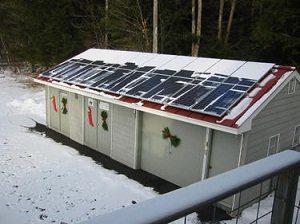Solar industry news week in review
 Well, 2010 is over, and today the world of 2011 really gets underway as people return to work from their long winter naps. It also heralds a new decade, perhaps the decade of solar? Despite supposedly being a sleepy news week, this past week was actually really busy in terms of solar.
Well, 2010 is over, and today the world of 2011 really gets underway as people return to work from their long winter naps. It also heralds a new decade, perhaps the decade of solar? Despite supposedly being a sleepy news week, this past week was actually really busy in terms of solar.
Clean Energy Authority rounded up some of the largest stories of the year, focusing on gains in the solar industry, and we also looked forward into 2011 with some predictions for 2011. In short, 2010 was the best year for solar in the U.S. and elsewhere, but 2011 promises to be even bigger. On the downside, some companies are likely to fail as the market gains more maturity.
During a supposedly slow news week, Abengoa Solar, a Spanish company, received a $1.45 billion loan from the U.S. to build the $2 billion Solana solar project in Arizona. The 250 megawatt solar thermal project will use molten salt as the thermal energy collector, allowing the plant to produce electricity for up to six hours after dark.
Photovoltaics don’t want to fall behind the solar market of course, and last week, China-based LDK Solar said its annual silicon wafer production capacity would reach 3 gigawatts annually. And two Chinese solar companies, ET Solar and Neo Solar Power, reached an agreement, under which Neo Solar will supply ET Solar with 370 megawatts of photovoltaics by 2013.
Elsewhere in the world, U.S.-based SunPower Corp. finalized its sale of the final phase of its Montalto di Castro Solar Park in Italy to an investment firm. The company said such sales agreements could become an industry standard. Another U.S.-based company, Sun Edison, also made the Italian headlines with news that the sale of its Rovigo Solar Power Plant was completed.
Despite heavy winter storms, the Northeast U.S. kept busy.
Looking forward into 2011, both New York and Connecticut may enact new solar and renewables legislation, offering growth opportunities for the industry.
In Connecticut Gov.-elect Dan Malloy already has said he’s likely to pass solar legislation that the former governor passed on.
Meanwhile the New York Solar Energy Industries Association is planning an ambitious 2011, which includes passing legislation fully funding the state’s goal of installing 5 gigawatts of solar by 2025.
Even with the punishing snows blanketing much of the northeastern U.S. over the past week, solar installers and power companies said their photovoltaic arrays experienced little or no problems with their installations. In fact, some noted that the snow sloughed off their systems as the underlying panels absorbed heat quicker than other parts of roofs.
One business owner in Massachusetts chose not to use the roofs of his buildings for solar. Rather he opted to power his businesses with a 240 kilowatt photovoltaic farm. Thanks to the state’s laws, the farm’s output will be counted directly toward his energy usage elsewhere.
In Vermont, Green Mountain Power said that it will build three photovoltaic-powered electric car charging stations in three different counties.
Not all the solar news was sunny. Tessera Solar’s Calico solar project lost its power-purchase agreement with Southern California Edison. The 663 megawatt installation will now be built by K Road Solar.
In Delaware, the First State Patriots, a conservative organization, raised concerns about who should pay for solar. And the group expressed concern that rate-payers are being forced to pay for solar-power whether or not they want to. This is a debate that may start appearing in other states, like Florida.
Image courtesy of the New Hampshire Sustainable Energy Association.



